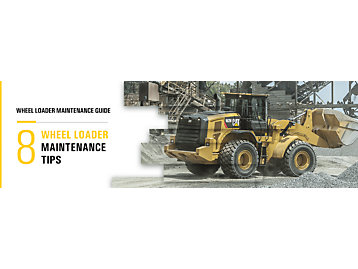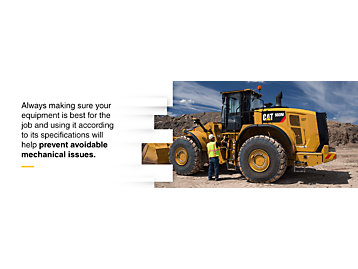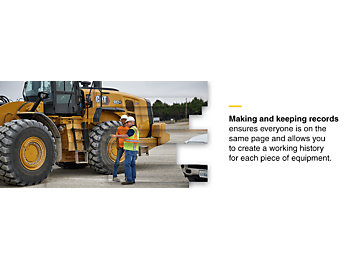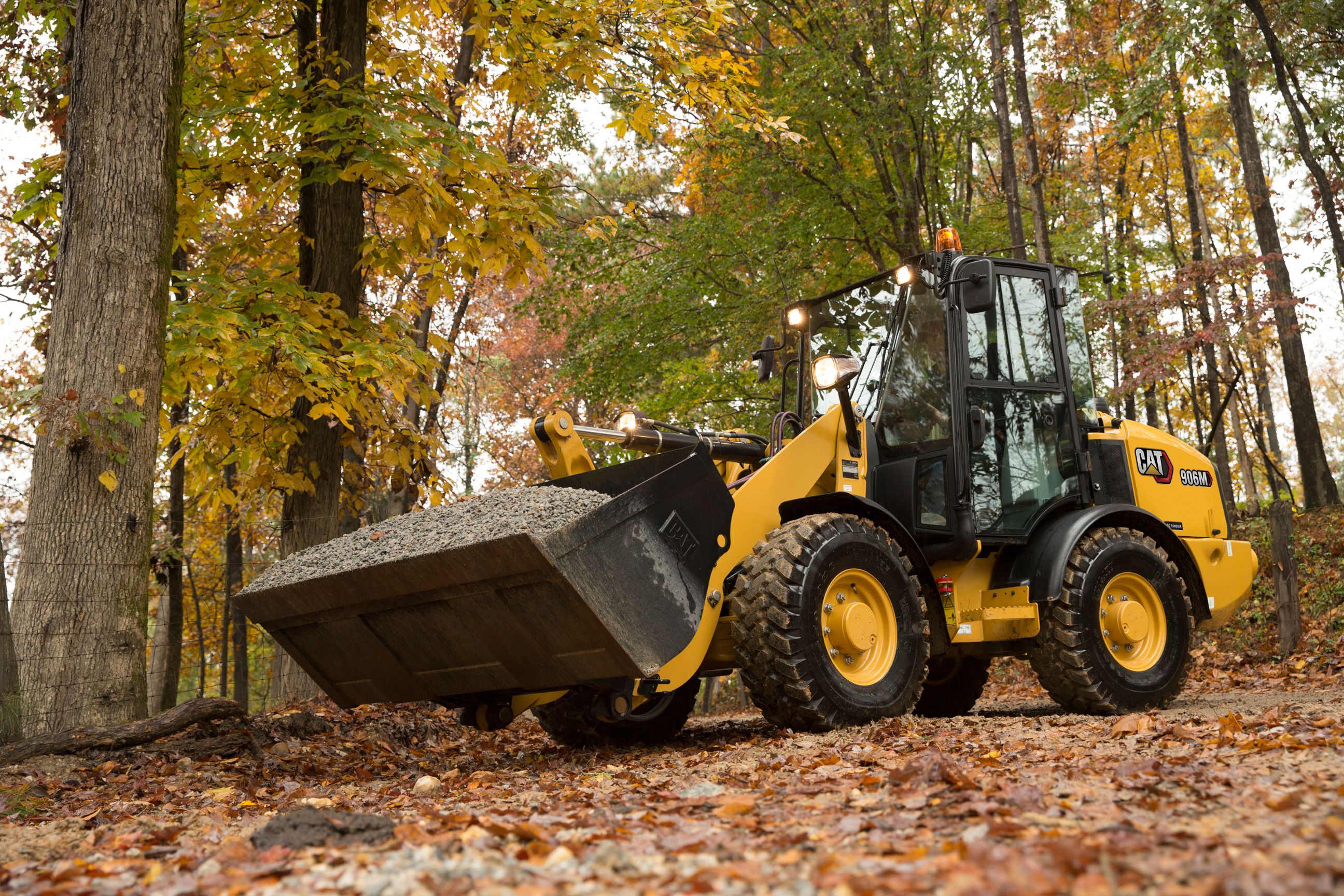

Sign In
Welcome! Sign In to personalize your Cat.com experience
If you already have an existing account with another Cat App, you can use the same account to sign in here
Register Now
One Account. All of Cat.
Your Caterpillar account is the single account you use to log in to select services and applications we offer. Shop for parts and machines online, manage your fleet, go mobile, and more.
Account Information
Site Settings
Security
Author: Small Business Expert | March 17, 2023 | Topic: Used Equipment

Construction equipment is an investment in your company's future. Proper maintenance helps you get the most out of your wheel loaders.
Taking just a few minutes each day to check on your equipment and make sure it's at optimal operation levels keeps your wheel loaders in great shape for years to come. Knowing what kinds of preventive maintenance to prioritize every shift is the first step to longer-lasting equipment that works at its best.
Luckily, some of the best tips for wheel loader maintenance are processes you can easily integrate into your existing work routine.
How to Maintain a Wheel Loader
Routine wheel loader maintenance is key to optimizing your team's performance on every job. Proper inspections can also extend the life of your equipment. When making an inspection and maintenance plan, keep these parts in mind:
- Fluids: Fluids are what keep your machine running smoothly. Coolant, powertrain fluids, hydraulic fluids, transmission fluids and engine oils all have individual ports for quick and easy checks. Keep extra fluids on hand to top off your machine's levels from time to time.
- Filters: Fluid filters help keep fluids clean from contaminants that can negatively affect your wheel loader's performance. Air filters help keep your machine's engine free from dust that can damage its operations or harm operators. Check all the filters often, clean any dirty or leaking filters immediately and replace any that are cracked or otherwise broken.
- Surface: Look closely for cracks anywhere along the wheel loader's surface, especially near any places subject to high wear like attachments and hinges. Also, check for signs of corrosion and address this issue right away, as leaving it can cause greater issues down the line.
- Hoses and cylinders: Check your hoses, tilt cylinders and lift cylinders for any signs of wear. These parts go through a lot of work to make your equipment run smoothly.
- Tires: Inspect your wheel loader's tires regularly, checking for deflation or worn treads. Depending on the conditions you're working in, dirt and mud can also become caked in tires. Inspect the metal rims for dents, rust or cracks that could impede the entire machine's structure.
- Lubricants: Keeping lubricants at optimal levels greatly increases your machine's life span by reducing friction between parts. Follow all manufacturer guidelines for lubricant levels, as adding too little or too much can have adverse effects. Also, make sure to use the correct lubricant for your machine and manufacturer, as different lubricants behave differently during machine operation.
- Powertrain: A wheel loader powertrain is crucial for smooth equipment operation, but it gets a lot of wear and tear on the job. Inspect each machine's powertrain daily, looking for debris, breaks, leaks, cracks and loose bolts. Clear any debris you find, tighten any loose bolts and replace any damaged parts.
- Buckets: Check on the bucket's cutting edges, corner guards and side-bar protectors to make sure they're not worn down to the base edge. A worn base edge can weaken the entire bucket structure, so you should always inspect bucket guards and protectors and replace any that are worn or damaged. Additionally, check for any cracks, and note any teeth that are loose or missing.
- Brakes: Make sure your machine's hydraulic brakes are well-oiled at all times. Oiled brakes ensure optimal performance, and decrease safety hazards.
- Cab: Your wheel loader's cab is where operators spend their time, so it should be in good condition for comfort and safety. Foot pedals, joysticks and other controls and technology should all work smoothly. Start the engine to make sure all gauges work as well.
- Hydraulic system: Check the entire hydraulic system for damaged hoses and make sure the hose couplings aren't broken or scratched. Also, inspect the cylinders for dents, scratches or leaks. Damaged cylinders could leak fluids or let contaminants enter the system.
- Engine: Look for any leaks or loose belts in your wheel loader's engine. Faulty engine parts can lead to costly downtime, so you should always make sure your loader's engine starts up easily and works well for the duration of every shift.
- Hardware: Look all around your wheel loader for any additional hardware that's missing or broken. If you discover any issues, replace those pieces before any further operation.
8 Wheel Loader Maintenance Tips
Beyond inspecting individual parts, you'll want to ensure your equipment operates well as a whole. Here are our best tips for maintaining wheel loaders:
1. Refer to the Manual
Before beginning any kind of maintenance or work with a machine, you and your team should familiarize yourselves with each wheel loader's operation and maintenance manual. Equipment manufacturers provide documents with a wealth of useful information about settings, features, safety and maintenance.
Your wheel loader maintenance guide can tell you optimal fluid levels and change intervals, as well as cleaning and replacement intervals for filters. This manual will also tell you about each wheel loader's specific capabilities.
2. Inspect Attachments
Attachments make your wheel loader more versatile, and you want to make sure all the pieces are in top condition for years to come.
Different attachments call for different maintenance requirements, depending on what they do and how often you use them. Buckets are used for scooping and carrying materials, while forks are best for moving palletized loads across job sites. You can also use brooms for clearing debris from surfaces, rakes for land-clearing applications and couplers for quickly switching between attachments.
Inspect all your attachments before use, replace any problematic parts immediately, and store attachments properly when you don't need them.
3. Keep Equipment Clean
While making sure all your wheel loader's moving parts are operable is the first step to proper maintenance, keeping the equipment clean can also prevent some major issues. If possible, try to keep your equipment out of dirty conditions to begin with. However, if you do need to operate in mud and grime, proper cleaning is crucial.
Contaminants can build up on internal and external parts and lead to overheating and faster wear rates. Caked-on dirt can also hide small scratches and cracks that could turn into larger issues if left unchecked. Clean and inspect your equipment immediately after spending any time working in dirty conditions.
Especially in winter, where some areas experience freezing temperatures, you should always clear the mud from your wheel loader before putting it away at the end of a shift. Caked-on mud can freeze overnight and be difficult to remove the next time you need to use the machine. Follow the manufacturer's guidelines for cleaning more delicate parts, like chains and bearings.
4. Winterize
If you work in an area where wintertime means freezing temperatures, winterizing your heavy equipment is the best way to keep your fleet operable all year long. Preparing for dropping temperatures helps you maintain your investment.
Winterizing your equipment includes paying attention to:
- Fluids: Before winter, drain all your loader's fluids and replace them with products specifically made to withstand cold temperatures.
- Fuel: Tanks with low fuel can freeze overnight, so filling your fuel tank at the end of each shift ensures you have an easy startup the next morning.
- Batteries: Cold engines require more startup power, so keep your loader's batteries charged. If possible, you can remove them and store them indoors when not in use.
- Block heaters: Block heaters warm your equipment's engine and fluids before each shift, so startup is easy even in the cold.
- Warming equipment: Run your wheel loader for a few minutes before beginning operations to help it reach ideal temperatures and reduce wear.
5. Store Equipment Properly
At all times of the year, storing your equipment in the proper places can vastly increase its life span. In the winter, indoor storage is best if possible. Even a temporary shelter on a job site helps keep your machines out of the snow.
In the summer, a shaded storage area helps protect your equipment from harsh sunlight. Heat can damage many parts of your wheel loader over time, so using tarps, tents or other shade structures can make a significant difference.
6. Operate Properly and Safely
One of the best ways to maintain your wheel loader long into the future is to use it properly at all times. The recommended usage specifications listed in the operation manual or provided by your dealer are professional best practices. Wheel loaders come in different sizes with different amounts of power, various attachments and other key features.
Avoid using a wheel loader that's too small for a job or doesn't have the right features, as this can overtax the machine and lead to issues. However, a wheel loader that's too large may have trouble navigating tighter work sites. Your work site may also have equipment weight requirements you'll need to follow. Choose loaders that comply with site weight requirements.
Be mindful of bucket and load capacity as well. Only lift load weights and sizes your wheel loaders are built to carry to ensure attachments stay in good condition.
Overall, always making sure your equipment is best for the job and using it according to its specifications will help prevent avoidable mechanical issues.

7. Make a Maintenance Program
Taking care of construction equipment is a big responsibility for your business, which is why you should have several wheel loader maintenance schedules in place.
A daily inspection checklist helps you get to know your equipment and spot issues as soon as they arise. Other regularly scheduled wheel loader maintenance checklists keep your loader running well by checking and replacing bigger parts. As soon as you add any machine to your fleet, set up maintenance appointments where a professional can inspect the equipment and help you spot any issues you may not recognize on your own.
You should also create a condition-based maintenance (CBM) program to help you further identify signs of wear before they turn into larger issues. CBM includes routine processes such as fluid analysis.
Determine who will be responsible for these different maintenance tiers. Your team can most likely handle much of the daily maintenance with the proper tools. For the larger processes, you may want to call in third-party help, such as an expert from your dealer.
8. Talk to Your Equipment Dealer
Trust your local professionals to give you sound advice for correct wheel loader use. Your dealer can help you maintain your equipment so it lasts a long time and meets your business needs.
Daily Wheel Loader Walkaround Inspection Checklist
Before and after each shift, check all the components of your wheel loader to ensure it's safe and ready for operation. If you find any issues, take care of them immediately, or refrain from using that machine until it can receive professional repairs.
Creating a daily wheel loader inspection checklist is the best way to keep track of all the important parts of your machine and help you find minor issues before they turn into big problems. Your checklist should include any aspects of your equipment that can fluctuate each day, including:
- Brakes
- Horns
- Lights
- Fluid levels
- Gauges
- Tire pressure
- Filters
- Hoses
- Cylinders
- Attachments
- Any other parts your user manual says to inspect
Ensure each part is clean, intact and does what it's supposed to do, so everyone can operate efficiently and safely.
In addition to running inspections at the beginning and end of each workday, watch out for any problems during operation and check for damages after any issues that happen while working.
During all inspections, have your team record their observations and submit them to a dedicated maintenance documents file. Making and keeping records ensures everyone is on the same page and allows you to create a working history for each piece of equipment.

Cat® Maintenance and Extended Protection Plans
When you add a wheel loader to your fleet, you want the peace of mind that your equipment will have the protection it needs so your business can weather any unexpected repairs.
Even the best-built machines eventually need repairs, which always seem to happen at the worst time — right in the middle of a big job, when cash is tight or just after the warranty expires. An Equipment Protection Plan (EPP) for a new or used machine provides coverage beyond the standard machine warranty for parts and labor and protects you from unplanned repair costs. Request more information about extended protection plans from your local Cat dealer.
Many Cat dealers also offer continuous support through Customer Value Agreements (CVA). CVAs are ownership plans that can help you get the most out of your Cat equipment. These agreements let you manage your equipment's health and give you access to hassle-free maintenance.
CVAs are incredibly customizable and flexible, so you'll receive the exact performance your business needs. You'll also have continuous access to genuine Cat parts, expert dealer support and Cat software that'll help you take your equipment to the next level.
Find a Cat Dealer Today
Now that you know more about Cat wheel loader maintenance, see what a difference an additional machine makes on the job. If you're looking for equipment, Cat Used has you covered. Shop used wheel loaders online to find the machine that meets all your specifications.
With Cat, you can buy used with confidence, knowing you have a knowledgeable support team every step of the way. Find a Cat dealer near you to start your search today!



